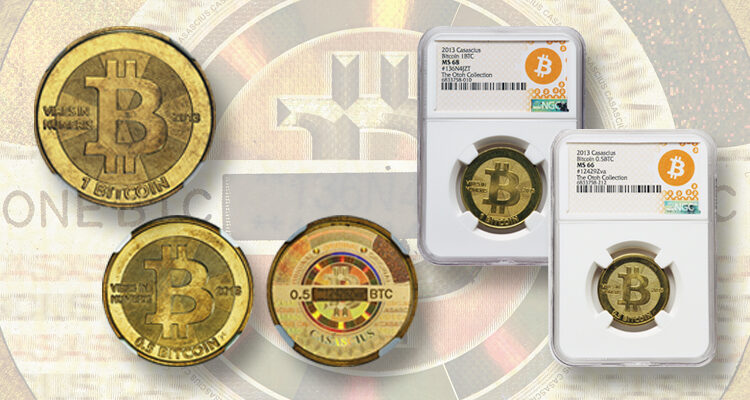
Heritage offered the Otoh Collection of Physical Cryptocurrency, Part I, on Nov. 3; the name coming from the bitcointalk.org forum username behind this accumulation of Casascius Coins.
Calling it one of the most important collections of cryptocurrency to come to the market, Heritage shared that the collection “is part of the legacy and the story of the remarkable journey of our client, an early adopter of Bitcoin, who possessed the foresight to engage directly with its creators in the nascent stages of its development. All the Casascius coins in their collection are directly obtained from Mike Caldwell, Casascius’ mastermind, providing a certain intimacy and authenticity to their ownership.”
The 250-lot session realized $7,198,200.
Caldwell introduced the first physical representation of Bitcoin with the Casascius Coins in 2011, “building a crucial link between cryptology’s computer wizardry and the physical world, fostering greater understanding, and quite literally, tangibility for the average person.”
These physical Bitcoins provided a straightforward alternative to complicated online platforms used to trade and store Bitcoin, while also becoming collectibles beyond their value as a Bitcoin, or fraction (or multiple) thereof. Caldwell issued an estimated 28,000 funded Casascius Coins between 2011 and 2013, each holding between 0.1 and 1,000 Bitcoin, and in total holding a value of over 90,000 Bitcoin.
Heritage’s catalog sets physical cryptocurrency in the framework of the history of currency, writing, “Regardless of its form through the ages, the quintessential attribute of ‘money’ lies in its broad acceptance for transactions — from trading of goods and services to debt settlements — by individuals, communities, and institutions alike.” Money functions as a standard of value and store of value, along with some physical characteristics like durability, portability, along with being hard to counterfeit.
While traditional notions of currency have stressed money as a physical entity that can be counted, touched and stored, Heritage writes, “the age of digital currencies, where value is dematerialized into units of coded data, or ‘bits,’ ” has caused a shift in the way financial value is perceived. Physical cryptocurrencies provide something tangible to represent the intangible, complex algorithms behind cryptocurrencies like Bitcoin.
Peeled or unpeeled?
Leading the offering were “unpeeled” physical Bitcoins that retain their value as a cryptocurrency. Heritage explains that the physical Bitcoins are etched with the initial segment of a public address and also with a corresponding private key. The public address is displayed on the coin, while the private key is placed within a recess on the other side and is safeguarded beneath a tamper-evident hologram. Peeling that hologram from a physical cryptocurrency piece reveals the concealed key for redeeming the Bitcoin’s digital value and removes the guarantee that the piece is not redeemed. The act also compromises the physical coin by rendering it defaced.
Heritage writes about peeling: “The action is laden with mixed anticipation and pang, as it simultaneously unlocks the digital wealth for redeeming the Bitcoin, yet marks the end of the physical coin’s intact aesthetic and resale value.”
Heritage estimates that around 20% of the roughly 28,000 issued Casascius Coins have been peeled.
$43,200 top lot price
Two unredeemed Casascius solid brass “loaded” (unredeemed) 2013 1-Bitcoin examples, both graded Mint State 68 by Numismatic Guaranty Co., realized $43,200 each. One of 8,352 issued, Heritage wrote, “Engulfed by an enticing blend of conventional numismatics and cutting-edge digital advancements, this exceptional piece stands out with its holographic embellishments and premium certified grade.” The price represented a premium over the price of a Bitcoin, which in the markets that day was worth $34,872. Of the multiple directly comparable examples in the sale, the least expensive sold for $38,400.
The least expensive item in the sale was a 2013 Casascius brass loaded (unredeemed) 0.5-Bitcoin piece graded MS-66 by NGC that sold for $16,800, one of 3,084 pieces total issued. Giving credit to the Heritage cataloger, who had to discover unique things to say of each of these visually similar piecess, the catalog entry observed: “The slightest turn of the wrist unleashes a tidal wave of brilliance across largely undisturbed fields.”
Connect with Coin World:
Sign up for our free eNewsletter
Access our Dealer Directory
Like us on Facebook
Follow us on X (Twitter)
Keep in touch on MyCollect – the social media platform for collectibles
Whether you’re a current subscriber or new, you can take advantage of the best offers on magazine subscriptions available in digital, print or both! Whether you want your issue every week or every month, there’s a subscription to meet your needs.






